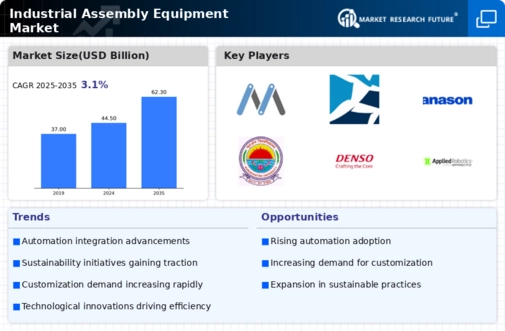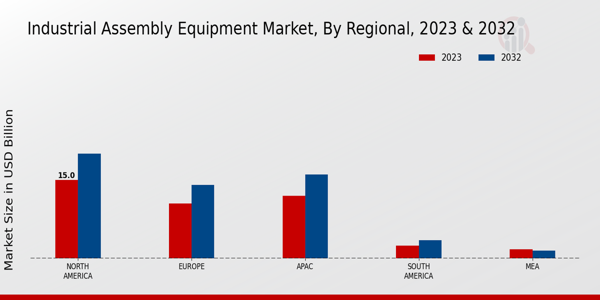Market Growth Projections
The Global Industrial Assembly Equipment Market Industry is projected to witness substantial growth over the coming years. With a market value expected to reach 44.5 USD Billion in 2024, the industry is poised for further expansion, potentially reaching 62.3 USD Billion by 2035. This growth trajectory suggests a compound annual growth rate (CAGR) of 3.12% from 2025 to 2035. Such projections indicate a robust demand for assembly equipment driven by technological advancements, customization needs, and sustainability initiatives. The market's resilience and adaptability to changing industrial landscapes will likely be key factors in its continued success.
Sustainability Initiatives
Sustainability initiatives are becoming a pivotal driver in the Global Industrial Assembly Equipment Market Industry. Manufacturers are increasingly adopting eco-friendly practices, which include the use of energy-efficient machinery and sustainable materials. This shift not only aligns with global environmental goals but also appeals to a growing segment of environmentally conscious consumers. As companies strive to reduce their carbon footprint, investments in sustainable assembly equipment are likely to rise. This trend may further stimulate market growth, as businesses recognize the long-term benefits of sustainability in enhancing brand reputation and operational efficiency.
Technological Advancements
The Global Industrial Assembly Equipment Market Industry is experiencing a surge in technological advancements, particularly in automation and robotics. These innovations enhance efficiency and precision in assembly processes, leading to reduced labor costs and increased productivity. For instance, the integration of artificial intelligence in assembly lines allows for real-time monitoring and adjustments, optimizing operations. As a result, the market is projected to reach 44.5 USD Billion in 2024, driven by the demand for smarter manufacturing solutions. Companies adopting these technologies are likely to gain a competitive edge, further propelling market growth.
Rising Demand for Customization
In the Global Industrial Assembly Equipment Market Industry, there is a notable shift towards customization in manufacturing processes. As consumer preferences evolve, manufacturers are increasingly required to produce tailored products, which necessitates flexible assembly equipment. This trend is reflected in the growing investment in modular assembly systems that can be easily reconfigured. The ability to adapt quickly to changing market demands is crucial for maintaining competitiveness. Consequently, this driver is expected to contribute to the market's expansion, with projections indicating a growth to 62.3 USD Billion by 2035.
Global Supply Chain Optimization
The optimization of global supply chains is a critical factor influencing the Global Industrial Assembly Equipment Market Industry. As companies seek to enhance their operational efficiency, they are investing in advanced assembly technologies that facilitate smoother logistics and inventory management. This trend is particularly relevant in the context of increasing globalization, where manufacturers must navigate complex supply chains. By streamlining assembly processes, businesses can reduce lead times and costs, thereby improving overall competitiveness. The market is expected to benefit from these developments, with a projected CAGR of 3.12% from 2025 to 2035.
Increased Investment in Manufacturing Infrastructure
In the Global Industrial Assembly Equipment Market Industry, there is a marked increase in investment in manufacturing infrastructure. Governments and private sectors are recognizing the importance of modernizing production facilities to enhance competitiveness. This investment encompasses not only the acquisition of advanced assembly equipment but also the development of smart factories equipped with IoT technologies. Such initiatives are likely to drive market growth, as enhanced infrastructure supports higher production capacities and improved quality control. The ongoing commitment to infrastructure development is expected to play a significant role in shaping the future of the assembly equipment market.


























Leave a Comment